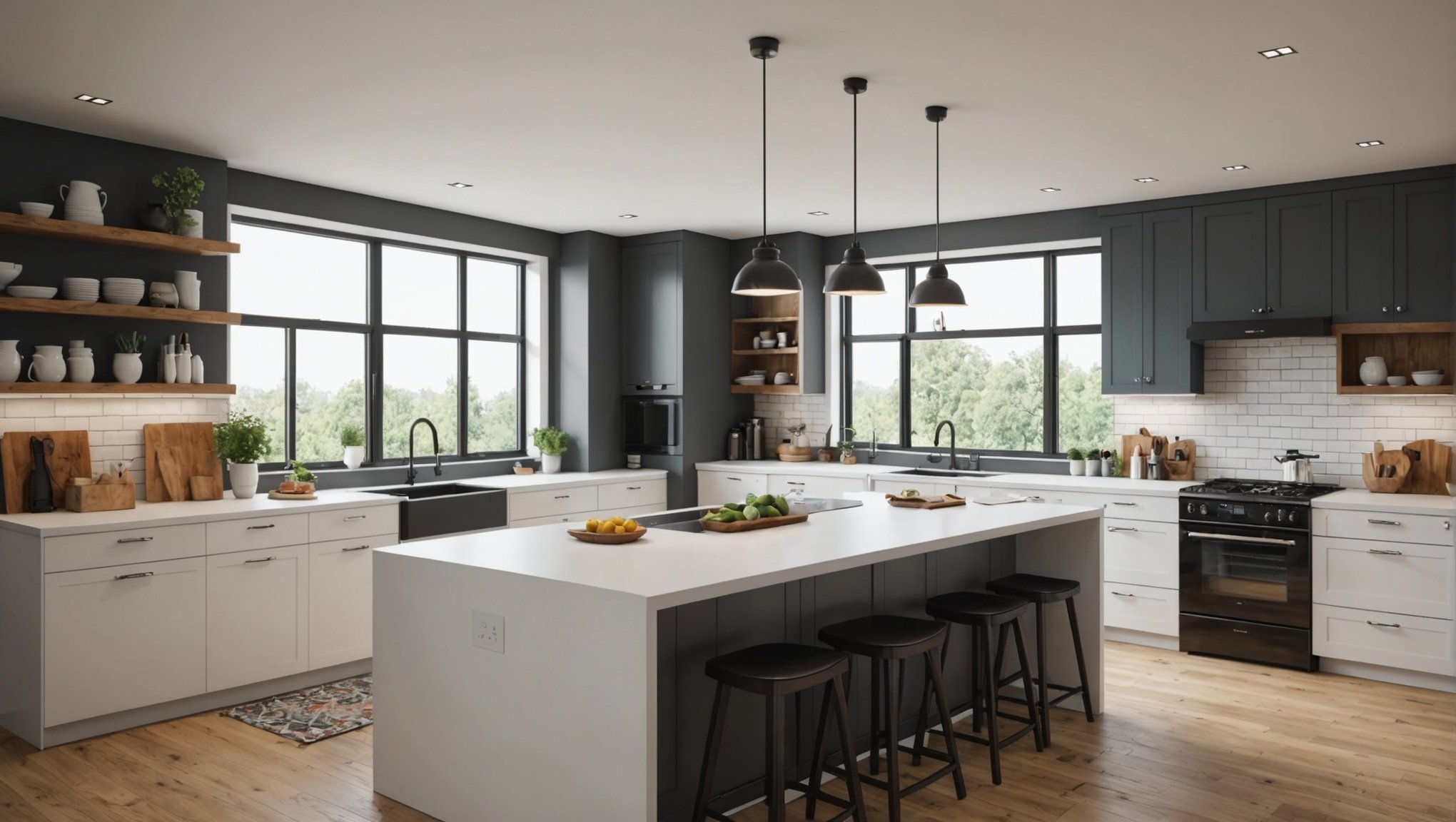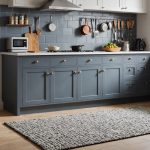Open-plan living spaces provide a modern, airy feel but often come with significant noise challenges, especially in the kitchen. Cooking, clattering dishes, and conversations can create a cacophony that disrupts your peace. Effective sound management is essential for a pleasant environment. Explore practical strategies to enhance kitchen acoustics, transforming your bustling space into a harmonious haven that balances functionality with comfort. Discover how to create a more serene atmosphere while still enjoying the vibrancy of open living.
Understanding Acoustics in Open-Plan Living Spaces
Open-plan designs are renowned for their spaciousness and fluidity, but they also present unique challenges in terms of acoustics. The absence of walls means sound can travel freely, often leading to issues with sound quality. In such environments, every noise, from a blender in the kitchen to a conversation in the living room, can impact the overall auditory experience.
Also to see : Top Creative Strategies to Seamlessly Blend a Microwave into Your Contemporary Kitchen Design
Impact of Open-Plan Design on Acoustics
Open-plan layouts can amplify sounds, making it difficult to control noise levels. This is primarily due to the lack of barriers that would typically absorb or block sound. As a result, sound quality may suffer, with echoes and reverberations becoming more pronounced.
Key Acoustic Principles in Kitchen Spaces
In kitchen areas, where open-plan designs are common, it’s essential to consider acoustic principles. Materials like soft furnishings, rugs, and acoustic panels can help mitigate noise by absorbing sound. These elements are crucial in maintaining a pleasant sound quality in such dynamic environments.
Also to see : Top Underfloor Heating Solutions for Your Ceramic Tiled Kitchen: A Complete Guide
Common Noise Sources in Open-Plan Living Areas
Noise sources in open-plan spaces are varied and can include kitchen appliances, televisions, and even footsteps on hard floors. Understanding these sources and their impact on acoustics is vital for creating a harmonious living environment. By addressing these challenges, one can enhance the sound quality and overall comfort of open-plan living spaces.
Effective Soundproofing Materials
In the quest to improve acoustics in open-plan spaces, selecting the right soundproofing materials is crucial. Kitchens, often bustling with activity, benefit significantly from thoughtful noise reduction strategies.
Overview of Soundproofing Materials for Kitchens
Soundproofing in kitchens can be achieved through various materials designed to absorb and dampen noise. Acoustic panels are popular due to their effectiveness in reducing echoes and reverberations. These panels are often made from dense materials that trap sound waves, preventing them from bouncing around the room. Additionally, sound-absorbing textiles like heavy curtains or fabric-covered panels can help soften harsh sounds, contributing to a more pleasant auditory environment.
Comparison of Acoustic Panels and Sound-Absorbing Textiles
When comparing acoustic panels to sound-absorbing textiles, each offers unique benefits. Acoustic panels are typically more effective at reducing a wide range of frequencies, making them ideal for spaces with high noise levels. They are often installed on walls or ceilings to maximise their impact. On the other hand, sound-absorbing textiles are versatile and can be easily integrated into the decor, providing a dual function of noise reduction and aesthetic enhancement. While they may not offer the same level of sound absorption as acoustic panels, they are excellent for mitigating moderate noise levels.
The Role of Insulation in Noise Reduction
Insulation plays a pivotal role in noise reduction by acting as a barrier that limits sound transmission between rooms. In open-plan designs, where walls are scarce, insulating floors and ceilings can significantly reduce the spread of noise. Materials like mineral wool or foam are effective insulators, offering both thermal and acoustic benefits. By incorporating insulation into the design, homeowners can enhance the sound quality in their living areas, creating a more serene and enjoyable environment.
Layout Considerations for Acoustic Improvement
In open-plan spaces, strategic layout choices are crucial for effective noise control. Thoughtful space planning can significantly enhance the acoustic environment by minimizing sound disturbances and improving overall comfort.
Strategic Placement of Furniture
The arrangement of furniture plays a key role in noise control. By strategically placing large pieces, such as bookshelves or sofas, you can create barriers that help absorb and diffuse sound. This not only reduces noise but also prevents sound waves from traveling freely across the room. Consider using furniture to section off areas, providing natural sound buffers within the space.
Benefits of Zoning in Open-Plan Layouts
Zoning is another effective technique in space planning for acoustic enhancement. By designating specific areas for different activities, you can manage sound more efficiently. For example, placing a dining area away from the kitchen can reduce the impact of kitchen noise during meals. Zoning creates distinct sound zones, allowing each area to maintain its own noise control strategy.
Flow and Circulation Considerations for Sound Management
The flow and circulation of a room also impact acoustics. Ensuring that pathways are clear and unobstructed helps maintain a balanced sound environment. By considering the movement of people through the space, you can design layouts that minimize noise disruptions. Thoughtful layout choices can thus enhance both the functionality and acoustic quality of open-plan living areas.
Acoustic Treatments and Solutions
When it comes to enhancing acoustics in open-plan spaces, a variety of acoustic treatments and soundproofing techniques can be employed to create a more harmonious auditory environment.
Overview of Professional Acoustic Treatment Options
Professional acoustic treatments often involve the installation of specialised materials designed to absorb or diffuse sound. These can include acoustic panels, bass traps, and diffusers, which are strategically placed to manage sound reflections and reduce echo. These treatments are particularly effective in spaces with high ceilings or hard surfaces, where sound tends to bounce and create unwanted noise.
DIY Soundproofing Solutions for Homeowners
For those looking to improve acoustics without professional intervention, there are several DIY solutions available. Homeowners can use soundproofing techniques such as adding heavy curtains, installing carpets or rugs, and using bookshelves or large furniture as sound barriers. These methods are cost-effective and can significantly reduce noise levels by absorbing sound waves and preventing them from travelling freely.
Innovations in Acoustic Design for Modern Kitchens
Modern kitchens, often part of open-plan designs, can benefit from innovative acoustic treatments. New materials and technologies, such as modular acoustic tiles and smart sound-absorbing devices, allow for customisable solutions that blend seamlessly with kitchen aesthetics. These innovations not only enhance soundproofing but also contribute to the overall design, making them a popular choice for contemporary homes.
Expert Tips and Case Studies
Delving into the world of acoustics, expert advice can provide invaluable insights for enhancing sound quality in open-plan spaces. Acoustics experts emphasize the importance of understanding the unique sound dynamics of each space. For instance, in a bustling kitchen, employing a mix of soundproofing materials and strategic layout adjustments can significantly reduce noise levels.
Insights from Acoustics Experts
Experts often suggest starting with a comprehensive sound assessment to identify problem areas. By pinpointing these zones, homeowners can tailor their acoustic treatments more effectively. One common recommendation is to incorporate a blend of acoustic panels and sound-absorbing textiles, which together can tackle a broad spectrum of frequencies.
Case Studies of Successful Sound Reduction Projects
Real-life case studies offer practical examples of successful sound reduction. In one project, a family transformed their noisy open-plan kitchen by installing ceiling-mounted acoustic panels and using thick rugs to dampen footstep sounds. This approach not only reduced echo but also improved the overall sound quality of the space.
Practical Tips for Implementing Changes Effectively
Implementing acoustic improvements can be straightforward with the right guidance. Experts suggest starting small, such as adding sound-absorbing textiles like curtains or rugs, before moving to more extensive modifications like installing acoustic panels. Additionally, rearranging furniture to create natural sound barriers can be a cost-effective method to enhance noise control.
Product Recommendations for Noise Reduction
When aiming to enhance kitchen acoustics, selecting the right soundproofing products is essential. There are several top-rated acoustic solutions available that cater to different needs and budgets.
Top-Rated Products for Soundproofing Kitchens
Among the leading soundproofing products, acoustic panels stand out for their effectiveness in reducing echoes and reverberations. These panels, often crafted from dense materials, are designed to trap sound waves, preventing them from bouncing around the kitchen. Another popular choice is soundproof curtains, which not only absorb noise but also add a decorative touch to the space.
Review of Acoustic Solutions Available on the Market
The market offers a variety of acoustic solutions. For instance, bass traps are ideal for kitchens with high ceilings, as they manage low-frequency sounds that can disrupt the auditory environment. Foam tiles are another option, providing a cost-effective way to cover large areas with sound-absorbing material. These solutions can be tailored to fit the specific acoustic challenges of any kitchen.
Budget-Friendly Options for Enhancing Kitchen Acoustics
For those on a budget, there are several affordable soundproofing products that can make a significant difference. Soundproofing mats can be placed under appliances to reduce vibrations, while weatherstripping can seal gaps in doors and windows to prevent sound leakage. These budget-friendly options allow homeowners to improve their kitchen’s acoustic quality without breaking the bank.
Visual Enhancements and Examples
Understanding the impact of acoustic improvements in open-plan spaces can be significantly aided by the use of visuals. These images not only illustrate the transformation but also serve as a powerful tool in conveying the effectiveness of soundproofing strategies.
Importance of Visuals in Understanding Acoustic Improvements
Visuals are crucial in demonstrating how soundproofing materials and techniques can alter a space’s auditory environment. By comparing before-and-after scenarios, homeowners can see the tangible benefits of implementing acoustic solutions. These images highlight changes in layout, material use, and overall design aesthetics, providing a clear picture of the potential impact on sound quality.
Gallery of Before-and-After Transformations
A curated gallery of before-and-after transformations showcases how different spaces have been enhanced through acoustic treatments. These examples offer a visual narrative, illustrating the journey from a noisy, echo-prone environment to a serene, well-balanced space. Each transformation tells a story of improved sound quality and increased comfort, inspiring homeowners to consider similar changes.
Design Inspiration for Quieter Open-Plan Living Spaces
For those seeking design inspiration, these visual examples provide a wealth of ideas for creating quieter open-plan living spaces. From the strategic placement of acoustic panels to the use of sound-absorbing textiles, these images demonstrate a variety of approaches to noise reduction. By exploring these visuals, homeowners can gather innovative ideas to enhance their own spaces, ensuring both aesthetic appeal and acoustic efficiency.






